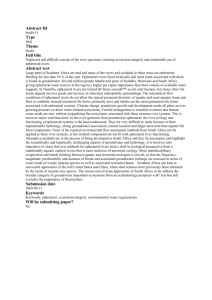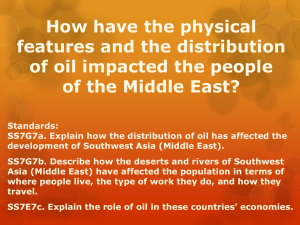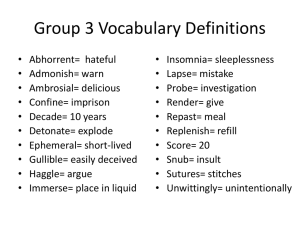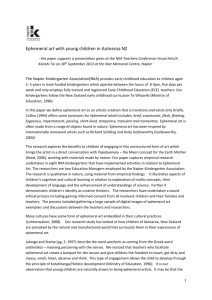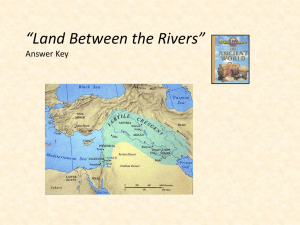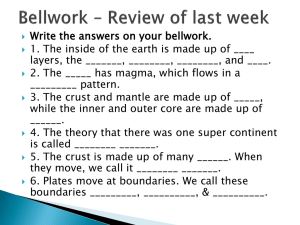Lesson 3 Arid Landforms- Wind and Water
advertisement
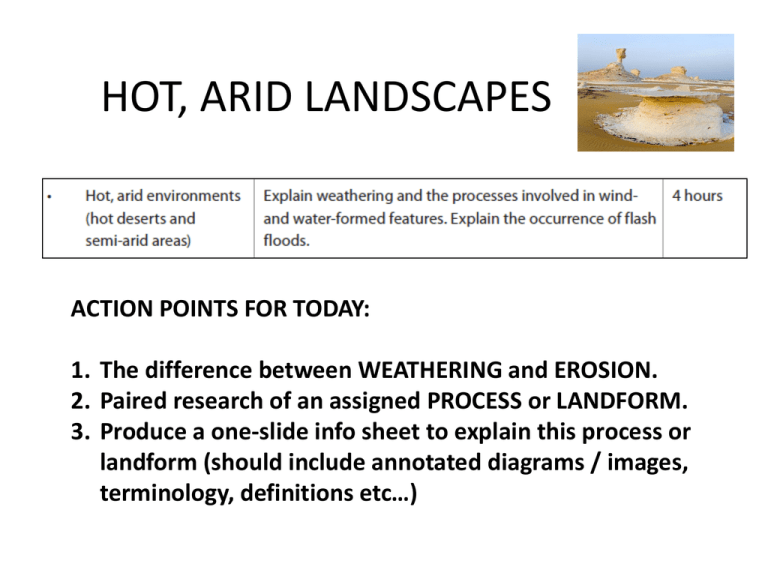
HOT, ARID LANDSCAPES ACTION POINTS FOR TODAY: 1. The difference between WEATHERING and EROSION. 2. Paired research of an assigned PROCESS or LANDFORM. 3. Produce a one-slide info sheet to explain this process or landform (should include annotated diagrams / images, terminology, definitions etc…) http://www.youtube.com/watch?feature=player_embedded&v=lyysL02ZvQ8# DEFINITIONS • Erosion is the breakdown of material that involves some movement of the material itself. • Weathering is when a material is broken down in situ (ie without moving). PROCESSES AEOLIAN (WIND) EROSION: DEFLATION and CORRASION/ABRASION; Jasper and Claudia WEATHERING: EXFOLIATION and SALT CRYSTALISATION; Patricia and Edric WIND LANDFORMS CRESCENT DUNES; James and Rachel YARDANGS; Heather and Nick ZEUGENS; Victoria and Larry WATER LANDFORMS WADI’S and CANYONS; Tushaar and Kana MESA’S BUTTES and SPIRES; Grace and Marco INSELBERGS; Himani and Arpit PAIRED TASK Create a one-slide info sheet to explain your process / landform. Include annotated diagrams, terminology and definitions. http://youtu.be/Mzan8ktsWWs Explain the occurrence of flash flooding… 1. When it rains in deserts, it often floods because there is little vegetation to intercept water in the soil and slow the surface runoff. 2. Sandstorm conditions are also ideal for rain storms, in which case flash flooding becomes a threat. The desert sand has low absorption, so heavy rains can produce flood conditions very quickly and without warning. Dry channels, ditches and lake beds will fill quickly and the water can be strong and violent, sometimes creating a wall of water 10 to 30 feet high. Remarkably, more people drown in the desert than die of thirst. Explain the occurrence of flash flooding… 3. Flash flooding occurs when precipitation falls too quickly on saturated soil or dry soil that is impermeable (has poor absorption ability). This is because there is limited opportunity for infiltration. The runoff collects in low-lying areas and rapidly flows downhill. Fluvial processes • Three main types of river are found in desert areas: 1. Exogenous rivers – sources outside the desert 2. Endoreic rivers – these form near the desert and never show beyond it 3. Ephemeral rivers – these flow for only part of the year. 1. Exogenous • These rivers continue to flow perennially, even though some of their discharge may be evaporated by high temperatures. 2. Endoreic • An endoreic, or closed water system, ends its journey inland rather than flowing into the ocean. Most endoreic systems terminate as a lake or a sea or, as in the Okavango River system, as a delta. • Both ephemeral and exogenous (perennial) systems can be endoreic, and paleohydrological evidence from around the world often shows that a system has changed from exoreic (flowing to the sea) to endoreic due to geological, climatic or environmental factors. 3. Ephemeral • In an ephemeral river, water flows sporadically and for short periods following heavy rain or snow melting in its catchment during spring. Water may flow for hours or even days, but rarely longer. • An ephemeral river is one in which measurable discharge occurs for less than 10% of the year. Over time, a particular river can change from perennial (where water flow is continuous) to ephemeral, or vice versa, depending upon climatic and environmental circumstances. • Another important feature of an ephemeral river is that, although the river channel’s surface may remain dry for most of the year, there is usually a significant volume of water stored beneath the channel.
